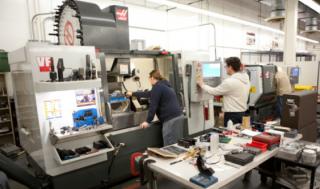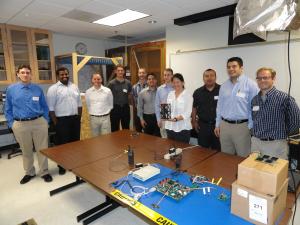 When current passes through a wire, it creates a magnetic field, called direct electromagnetic coupling. The stronger the current, the stronger the magnetic field. But reduce things down to the nanoscale, and passing current through a wire won’t work as well—most of the current is lost to heat.
When current passes through a wire, it creates a magnetic field, called direct electromagnetic coupling. The stronger the current, the stronger the magnetic field. But reduce things down to the nanoscale, and passing current through a wire won’t work as well—most of the current is lost to heat.
With magnetic fields still needed at the nanoscale, researchers at the NSF-funded Center for Translational Applications for Nanoscale Multiferroic Systems (TANMS) found they could bypass the limitations of direct electromagnetic coupling by pairing a material that produces a magnetic field with one that creates an electrical field though mechanical strain, called “strain-mediated electromagnetic coupling.” A collaboration among CSUN, UCLA (where it is housed), UC Berkeley and Cornell University, as well as various research labs and industry partners from around the world, the center is using this technology to focus on three applications—nano motors, nano antennae and nano memory. (Multiferroic in the center’s name refers to composite materials consisting of piezoelectric and magnetostrictive materials.)
CECS assistant professor of mechanical engineering George Youssef is the center’s education director, overseeing the college education program and assisting with precollege education. He is also conducting related research with his students. In one project, he and his team are creating a macroscale physical simulator of multiferroic nanomotors.
“We want to see how coupling these materials will create enough torque to move something, and what the efficiency of the motors is,” he says.
In tandem with the simulator, he is working on creating thin-film PZT, a piezoelectric material, and will use a photoelasticity measurement technique to quantify the in-plane strain due to the application of an electrical field on the thin-film PZT.
“We want to know the limits of the strain that can be generated without causing cracks so we’ll understand later on how strong the magnetic field will be,” he explains.
The impetus behind the TANMS project is miniaturization of electronic devices for biomedical applications. The long-range vision for the center is to create a miniature submarine that can navigate in the bloodstream and go to remote places in the brain, sending information so investigators can better understand why conditions like concussion, for example, happen and how they can be treated.
A message from the Dean
February 6, 2014Industry partnerships – HAAS
February 6, 2014Industry Partnerships – Jet Propulsion Laboratory
February 6, 2014
Leave a reply Cancel reply
-
Digital Watermarking Project Promises to Save Time and Lives
February 22, 2011 -
Conferences: Assistive technology goes international…again
February 6, 2014 -
Design Clinics: Antenna Measurement Lab: Computer-aided processing
February 6, 2014



